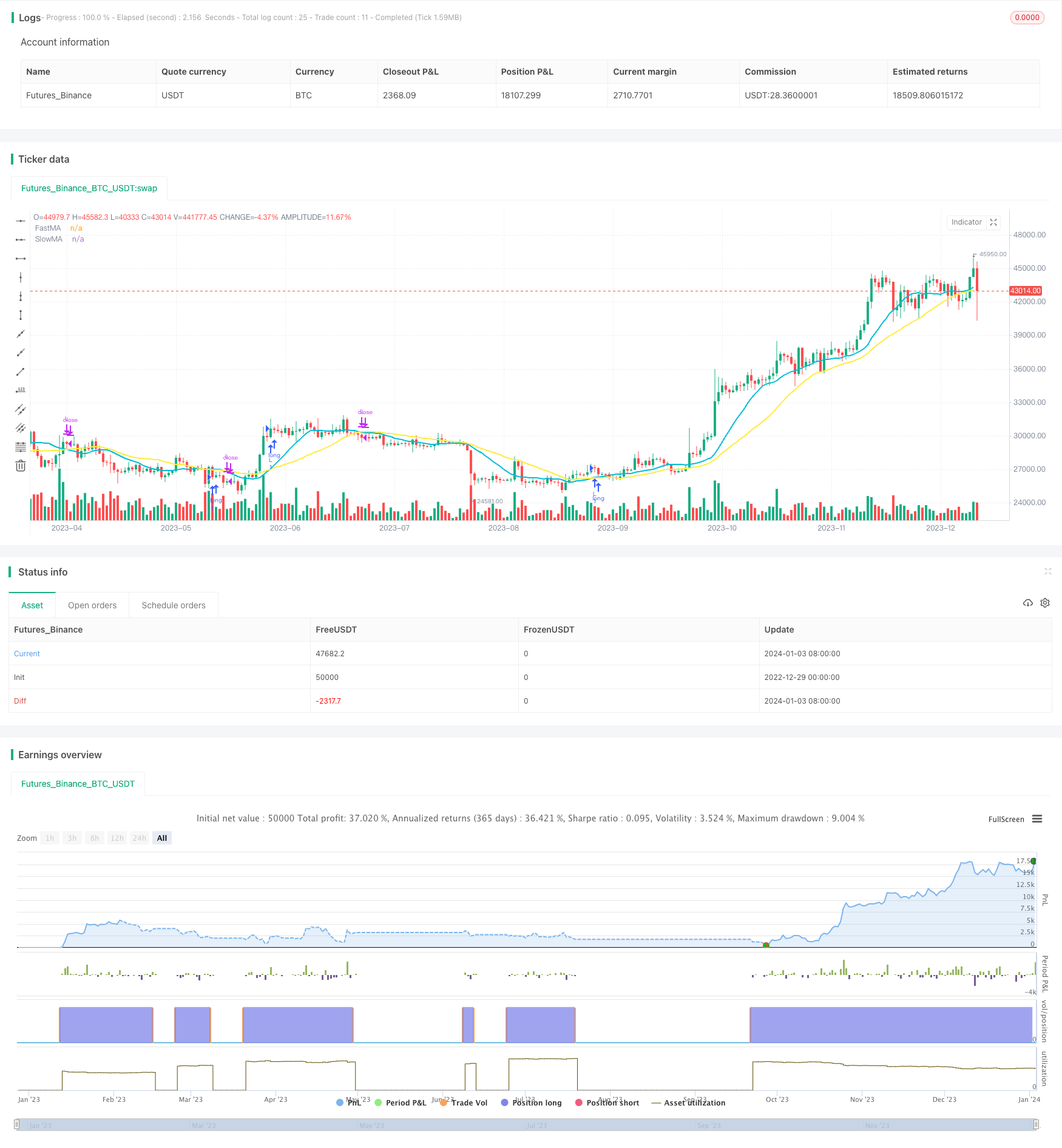Adaptive Backtest Date Range Selection Strategy Based on Double MA
Author: ChaoZhang, Date: 2024-01-05 12:12:10Tags:

Overview
The core idea of this strategy is to implement a framework that can flexibly select the backtest date range to meet different needs of users, so that they can automatically or manually set the start and end times for backtest.
The strategy provides four options for date range selection through input parameters: using all history data, recent specified days, recent specified weeks or manually specifying a date range. The strategy will dynamically set the backtest window based on the selected date range, while keeping the trading logic unchanged, so that the performance difference under different time windows can be compared.
Strategy Principle
The strategy consists of two modules: backtest date range selection and double MA trading strategy.
Backtest Date Range Selection Module
- Provides four options for date range selection: all history data (ALL), recent specified days (DAYS), recent specified weeks (WEEKS), manually specified date range (MANUAL).
- Dynamically sets the backtest start and end time based on timestamp conversion of the selected range.
- Uses time condition window() function to filter candles and only do backtest within selected date range.
Double MA Trading Strategy Module
- Fast MA period is fastMA, default 14; slow MA period is slowMA, default 28.
- Long when fast MA crosses over slow MA; close position when fast MA crosses below slow MA.
- Plots fast and slow MA curves.
Analysis of Advantages
- Flexibly selects different backtest date ranges without limitation to meet different experimental needs.
- Can test the effects of different period parameters within the same time frame with comparability of results.
- Easy to modify trading logic to serve as framework for other strategies.
- Simple to understand double MA strategy, easy for beginners.
Analysis of Risks and Solutions
- Double MA strategy is crude with frequent buying/selling issues. Consider adding stop loss etc. for optimization.
- Manually setting date range needs caution to avoid errors. Can show alert messages.
- Long history backtest increases test cycle. Can consider adding slippage or fees to reduce frequent trades.
Directions for Strategy Optimization
- Add stop loss logic to lower risk of loss.
- Filter stocks with stocks pool by strong index relevance for higher stability.
- Add filters to remove unstable signals within certain periods to reduce unnecessary trades.
- Test performances of stocks indexes to find the best varieties.
Conclusion
As a flexible and customizable framework for date range selection, the advantages are meeting different test needs of users. Combined with simple but effective double MA trading logic, it can quickly verify and compare strategies. Follow-up optimizations like adding filters or stop loss logic can make the strategy more practical for live trading. In summary, the strategy framework has good scalability and reference value.
/*backtest
start: 2022-12-29 00:00:00
end: 2024-01-04 00:00:00
period: 1d
basePeriod: 1h
exchanges: [{"eid":"Futures_Binance","currency":"BTC_USDT"}]
*/
//@version=4
strategy(title = "How To Auto Set Date Range", shorttitle = " ", overlay = true)
// Revision: 1
// Author: @allanster
// === INPUT MA ===
fastMA = input(defval = 14, title = "FastMA", type = input.integer, minval = 1, step = 1)
slowMA = input(defval = 28, title = "SlowMA", type = input.integer, minval = 1, step = 1)
// === INPUT BACKTEST RANGE ===
useRange = input(defval = "WEEKS", title = "Date Range", type = input.string, confirm = false, options = ["ALL", "DAYS", "WEEKS", "MANUAL"])
nDaysOrWeeks = input(defval = 52, title = "# Days or Weeks", type = input.integer, minval = 1)
FromMonth = input(defval = 9, title = "From Month", minval = 1, maxval = 12)
FromDay = input(defval = 15, title = "From Day", minval = 1, maxval = 31)
FromYear = input(defval = 2019, title = "From Year", minval = 2014)
ToMonth = input(defval = 12, title = "To Month", minval = 1, maxval = 12)
ToDay = input(defval = 31, title = "To Day", minval = 1, maxval = 31)
ToYear = input(defval = 9999, title = "To Year", minval = 2014)
// === FUNCTION EXAMPLE ===
window() => true
// === LOGIC ===
buy = crossover(sma(close, fastMA), sma(close, slowMA)) // buy when fastMA crosses over slowMA
sell = crossunder(sma(close, fastMA), sma(close, slowMA)) // sell when fastMA crosses under slowMA
// === EXECUTION ===
strategy.entry("L", strategy.long, when=window() and buy) // buy long when "within window of time" AND crossover
strategy.close("L", when=window() and sell) // sell long when "within window of time" AND crossunder
// === PLOTTING ===
plot(sma(close, fastMA), title = 'FastMA', color = color.aqua, linewidth = 2, style = plot.style_line) // plot FastMA
plot(sma(close, slowMA), title = 'SlowMA', color = color.yellow, linewidth = 2, style = plot.style_line) // plot SlowMA
- Price Drop Buy Strategy in Downtrend with Stop Loss
- Reversal Momentum Compound Strategy
- Quantitative Trading Strategy Based on EMA Crossover
- Ichimoku Cloud Quantitative Trading Strategy
- Trend Following Moving Average Trading Strategy
- Trend Following Momentum Breakout Strategy
- Breakout and Intelligent Bollinger Bands Price Channel Strategy
- Simple Trend Following Strategy
- Long Breakthrough Strategy Based on K-Line Construction
- Momentum Oscillating Moving Average Trading Strategy Based on Buffered Bollinger Bands
- Multi-Timeframe Moving Average Crossover Optimization Strategy
- Breakthrough Tracking Strategy
- Adaptive Trading Strategy Based on Momentum Indicators
- Pivot Point and Fibonacci Retracement Based Automatic Trend Following Strategy
- Trend Following Strategy Based on EMA and MACD across Timeframes
- Multi-indicator Collision Reversal Strategy
- Trend Reversal Strategy Based on EMA and SMA Crossover
- DMI DPO Guard Strategy
- Trend Tracking Short-term Trading Strategy
- RSI Trend Following Bull Strategy